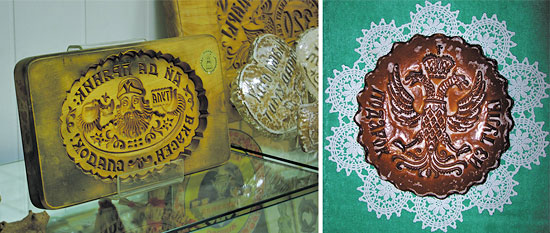TULA GINGERBREAD
Gingerbread has been popular for years in Russia, yet no reliable sources can be found to determine when gingerbread was invented. Researchers believe that gingerbread was baked dozens if not hundreds of millennia ago. The ancient ritual described in the dictionary compiled by Vladimir Dahl confirms this myth. “On the second day of their marriage the newlyweds visit the bride’s parents with gingerbread as a present”, Dahl wrote. This reference to gingerbread shows the deeply archaic roots of the gingerbread tradition during weddings, going back to the times of the matriarchate, when women played a leading role in society.
The best gingerbread was baked in the 17th – 19th centuries in Archangelsk, Vologda, Moscow, Tver, and Tula.
Tula gingerbread is one of the most popular kinds. It made famous not only the city of Tula, but also Russia as a whole. Tula gingerbread is as popular as the Tula samovar, and much older. Tula gingerbread was first mentioned in chronicles of 1685. The chronicler reports that in the 17th century gingerbread was baked in Tula in many varieties, including mint and honey-flavored kinds, and gingerbread with impressed letters, pictures or intricate patterns.
There were many customs, traditions, and beliefs associated with gingerbread. Gingerbread was baked for various purposes: as presents, parting gifts, wedding gifts, anniversary gifts, Christmas gifts, and Easter gifts. Gingerbread was also traditionally served at wakes. Gingerbread was served at any major holiday, and special custom-made gingerbread was baked for most important events.
Gingerbread makers were known as pryanishniks, and the trade was often passed from father to son.
Gingerbread was baked in forms. The appearance and beauty of the product depended on the quality of the form. Although there are no samples of old gingerbread surviving to this day, some old gingerbread forms have remained. They are known as “gingerbread boards” and they come in an astounding variety of shapes and forms, introducing us to traditions and customs of ages past, and showing little known pages of peasant and city life in Russia. The boards were made of birch and pear wood. Lower sections of thirty-year-old trees were used. Gingerbread was valued not only for its taste but for its appearance as well, so the carving of the forms was a very important process. Indeed, carvers of gingerbread boards were co-authors in the work done by the bakers.
Gingerbread was made just like bread in villages, and later, in cities. There were five major types of gingerbread boards: rectangular, ornamental, sectional, honorable, and urban. Rectangular boards were thus named for the shape of the board. They contained simple patterns with varying depths of carved elements. Ornamental boards contained ornamental patterns with intricate details. These boards were mostly used to bake gingerbread for ordinary citizens and children. Sectional boards were used to bake smaller gingerbread loaves. The large board was divided into sections, and each section had its own complete pattern. The so-called honorable boards were used in rich homes. They contained intricate carved elements of high artistic value. These were the dominating types of gingerbread boards in mid 18th century. All the boards were large, and the weight of some of the loaves reached several poods.
Urban boards were smaller, and usually contained a carved inscription with the name of the city where the bread was baked.
There exist many types of gingerbread, with different recipes, ingredients, shapes and uses.
Small gingerbread cakes were the oldest and the most widespread variety. They were simple yet original.
Patterned gingerbread was called thus for the patterns on gingerbread boards. They were especially popular. The patterned gingerbread was baked with the help of special boards with printed figures and patterns that stood out on the baked gingerbread.
Gingerbread cakes were usually of artistic value and a favorite children’s treat. The cakes were baked in the form of fish, birds, names, and individual letters.
Gingerbread with inscriptions on it was especially precious. Carving a pattern on the board was quite hard, and making an inscription was still harder.
In the 18th and 19th centuries gingerbread was made of sour dough and unleavened dough.
Sour gingerbread was made of inoculated dough. It was more expensive and in demand among wealthy citizens. Dark-brown gingerbread, made of honey and molasses, was rich and sumptuous. Poor people usually made unleavened gingerbread, which was cheaper and easier to make.
Tula gingerbread was considered an expensive gift. According to folk beliefs, gingerbread had medicinal properties and helped treat diseases. These special kinds of gingerbread were baked on gingerbread boards with carved letters corresponding to the names of Archangels.
In the 19th century peasant gingerbread was squeezed out by factory-made gingerbread. Gradually gingerbread lost its ceremonial importance and became a simple kind of food.
Despite the confectionary field now being mostly automated, gingerbread is still made manually: art can not be turned into a mere product.

